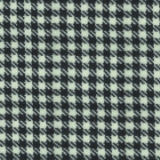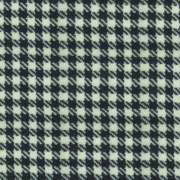
Border tartan
Encyclopedia
Border tartan, sometimes known as Northumbrian tartan, Shepherds' Plaid or Border Drab, or Border check is a design used in woven fabrics historically associated with the Anglo-Scottish Border
, including the Scottish Borders
and Northumberland
.

 The modern Border tartan is a crossweave of small dark and light checks, much plainer than the better-known Scottish tartans
The modern Border tartan is a crossweave of small dark and light checks, much plainer than the better-known Scottish tartans
http://www.scotchcorner.com/mill/tartans-n/northumbrian.html. Traditionally, the yarn for the light squares was simply untreated sheep's wool and the darker yarn was the same wool dyed with simple vegetable dyes, such as alder bark or water flag, or the untreated wool of a black sheep. http://www.northumberlandtartan.co.uk/history.html.
Modern Border Tartans are almost invariably a bold black and white check, but historically the light squares were the yellowish colour of untreated wool, with the dark squares any of a range of dark grays, blues, greens or browns; hence the alternative name of "Border Drab." At a distance the checks blend together making the fabric ideal camouflage
for stalking game.
This style of tartan is one of the oldest in existence http://www.visitnorthumberland.com/site/highlights/cultural-heritage as fragments of similar tartans have been found in Great Britain
and Jutland
.
One similar fragment was discovered in an earthenware pot filled with silver coins, at the Antonine Wall
in Falkirk, Scotland (giving it the name Falkirk Sett). This fragment, known as the Falkirk
tartan is currently the earliest check or tartan fragment found in the British Isles and dates back to Roman
times (around the 3rd century CE). It is now kept in the National Museum of Scotland
. The Celts were said by Roman scholars to wear bright stripes, that some have suggested are actually descriptions of the brighter variants of tartan. http://www.scotshistoryonline.co.uk/tartan-history.html
Another similar tartan was found on a cloak, in the peat bog at Thorsberg, in the modern-day Schleswig-Holstein
region of northern Germany
. In Anglo-Saxon England
, though check was commonly used, its use in Schleswig is thought to have been greater (even as far as being used for tunics, unlike in England where tunics were usually plain hues, with cloaks and trouser being the most common check garments), suggesting that the continental Germanic peoples of the area used the design to an even greater extent than those in England.
Border tartan is possibly the easiest tartan to create due to its use of natural colours and undyed wool http://www.northumberlandtartan.co.uk/history.html http://www.scotshistoryonline.co.uk/tartan-history.html.
From this general check pattern came the Houndstooth
variant, first developed in Lowland Scotland. This check now famous for being used as the design for traditional Chefs' trousers
, where the camouflage pattern is used to hide minor stains.
In Sketches by Boz
, a collection of short pieces published by Charles Dickens
, "The Shepherds' Plaid" is mentioned. http://www.worldwideschool.org/library/books/lit/charlesdickens/SketchesbyBoz/chap46.html
The Border tartan has long been worn by the retainers of the House of Percy
. In 1760 it was adopted as the official tartan of the Duke of Northumberland
's piper. It is also the official plaid for pipers of the Northumberland Fusiliers http://www.regiments.org/tradition/tartans/northumb.htm.
Anglo-Scottish border
The Anglo-Scottish border is the official border and mark of entry between Scotland and England. It runs for 154 km between the River Tweed on the east coast and the Solway Firth in the west. It is Scotland's only land border...
, including the Scottish Borders
Scottish Borders
The Scottish Borders is one of 32 local government council areas of Scotland. It is bordered by Dumfries and Galloway in the west, South Lanarkshire and West Lothian in the north west, City of Edinburgh, East Lothian, Midlothian to the north; and the non-metropolitan counties of Northumberland...
and Northumberland
Northumberland
Northumberland is the northernmost ceremonial county and a unitary district in North East England. For Eurostat purposes Northumberland is a NUTS 3 region and is one of three boroughs or unitary districts that comprise the "Northumberland and Tyne and Wear" NUTS 2 region...
.


Tartan
Tartan is a pattern consisting of criss-crossed horizontal and vertical bands in multiple colours. Tartans originated in woven wool, but now they are made in many other materials. Tartan is particularly associated with Scotland. Scottish kilts almost always have tartan patterns...
http://www.scotchcorner.com/mill/tartans-n/northumbrian.html. Traditionally, the yarn for the light squares was simply untreated sheep's wool and the darker yarn was the same wool dyed with simple vegetable dyes, such as alder bark or water flag, or the untreated wool of a black sheep. http://www.northumberlandtartan.co.uk/history.html.
Modern Border Tartans are almost invariably a bold black and white check, but historically the light squares were the yellowish colour of untreated wool, with the dark squares any of a range of dark grays, blues, greens or browns; hence the alternative name of "Border Drab." At a distance the checks blend together making the fabric ideal camouflage
Camouflage
Camouflage is a method of concealment that allows an otherwise visible animal, military vehicle, or other object to remain unnoticed, by blending with its environment. Examples include a leopard's spotted coat, the battledress of a modern soldier and a leaf-mimic butterfly...
for stalking game.
This style of tartan is one of the oldest in existence http://www.visitnorthumberland.com/site/highlights/cultural-heritage as fragments of similar tartans have been found in Great Britain
Great Britain
Great Britain or Britain is an island situated to the northwest of Continental Europe. It is the ninth largest island in the world, and the largest European island, as well as the largest of the British Isles...
and Jutland
Jutland
Jutland , historically also called Cimbria, is the name of the peninsula that juts out in Northern Europe toward the rest of Scandinavia, forming the mainland part of Denmark. It has the North Sea to its west, Kattegat and Skagerrak to its north, the Baltic Sea to its east, and the Danish–German...
.
One similar fragment was discovered in an earthenware pot filled with silver coins, at the Antonine Wall
Antonine Wall
The Antonine Wall is a stone and turf fortification built by the Romans across what is now the Central Belt of Scotland, between the Firth of Forth and the Firth of Clyde. Representing the northernmost frontier barrier of the Roman Empire, it spanned approximately 39 miles and was about ten feet ...
in Falkirk, Scotland (giving it the name Falkirk Sett). This fragment, known as the Falkirk
Falkirk
Falkirk is a town in the Central Lowlands of Scotland. It lies in the Forth Valley, almost midway between the two most populous cities of Scotland; north-west of Edinburgh and north-east of Glasgow....
tartan is currently the earliest check or tartan fragment found in the British Isles and dates back to Roman
Ancient Rome
Ancient Rome was a thriving civilization that grew on the Italian Peninsula as early as the 8th century BC. Located along the Mediterranean Sea and centered on the city of Rome, it expanded to one of the largest empires in the ancient world....
times (around the 3rd century CE). It is now kept in the National Museum of Scotland
National Museum of Scotland
The National Museum of Scotland, Edinburgh, Scotland, was formed in 2006 with the merger of the Museum of Scotland, with collections relating to Scottish antiquities, culture and history, and the Royal Museum next door, with collections covering science and technology, natural history, and world...
. The Celts were said by Roman scholars to wear bright stripes, that some have suggested are actually descriptions of the brighter variants of tartan. http://www.scotshistoryonline.co.uk/tartan-history.html
Another similar tartan was found on a cloak, in the peat bog at Thorsberg, in the modern-day Schleswig-Holstein
Schleswig-Holstein
Schleswig-Holstein is the northernmost of the sixteen states of Germany, comprising most of the historical duchy of Holstein and the southern part of the former Duchy of Schleswig...
region of northern Germany
Germany
Germany , officially the Federal Republic of Germany , is a federal parliamentary republic in Europe. The country consists of 16 states while the capital and largest city is Berlin. Germany covers an area of 357,021 km2 and has a largely temperate seasonal climate...
. In Anglo-Saxon England
England
England is a country that is part of the United Kingdom. It shares land borders with Scotland to the north and Wales to the west; the Irish Sea is to the north west, the Celtic Sea to the south west, with the North Sea to the east and the English Channel to the south separating it from continental...
, though check was commonly used, its use in Schleswig is thought to have been greater (even as far as being used for tunics, unlike in England where tunics were usually plain hues, with cloaks and trouser being the most common check garments), suggesting that the continental Germanic peoples of the area used the design to an even greater extent than those in England.
Border tartan is possibly the easiest tartan to create due to its use of natural colours and undyed wool http://www.northumberlandtartan.co.uk/history.html http://www.scotshistoryonline.co.uk/tartan-history.html.
From this general check pattern came the Houndstooth
Houndstooth
Houndstooth, houndstooth check or hound's tooth , also known as dogstooth, dogtooth or dog's tooth, is a duotone textile pattern characterized by broken checks or abstract four-pointed shapes, often in black and white, although other colours are used...
variant, first developed in Lowland Scotland. This check now famous for being used as the design for traditional Chefs' trousers
Chef's uniform
The traditional chef's uniform includes a toque , white double-breasted jacket, and checkered pants. It is a common uniform in the Western world....
, where the camouflage pattern is used to hide minor stains.
Popular culture
Sir Walter Scott was famed for wearing trousers of Border tartan, thus starting a fashion for checked clothing in Victorian London. http://www.northumberlandtartan.co.uk/history.htmlIn Sketches by Boz
Sketches by Boz
Sketches by "Boz," Illustrative of Every-day Life and Every-day People is a collection of short pieces published by Charles Dickens in 1836 accompanied by illustrations by George Cruikshank. The 56 sketches concern London scenes and people and are divided into four sections: "Our Parish",...
, a collection of short pieces published by Charles Dickens
Charles Dickens
Charles John Huffam Dickens was an English novelist, generally considered the greatest of the Victorian period. Dickens enjoyed a wider popularity and fame than had any previous author during his lifetime, and he remains popular, having been responsible for some of English literature's most iconic...
, "The Shepherds' Plaid" is mentioned. http://www.worldwideschool.org/library/books/lit/charlesdickens/SketchesbyBoz/chap46.html
The Border tartan has long been worn by the retainers of the House of Percy
House of Percy
The House of Percy were the most powerful noble family in Northern England for much of the Middle Ages, having descended from William de Percy who crossed from Normandy to England with William I in early December 1067 and was rebuilding York Castle in 1070...
. In 1760 it was adopted as the official tartan of the Duke of Northumberland
Duke of Northumberland
The Duke of Northumberland is a title in the peerage of Great Britain that has been created several times. Since the third creation in 1766, the title has belonged to the House of Percy , which held the title of Earl of Northumberland from 1377....
's piper. It is also the official plaid for pipers of the Northumberland Fusiliers http://www.regiments.org/tradition/tartans/northumb.htm.

